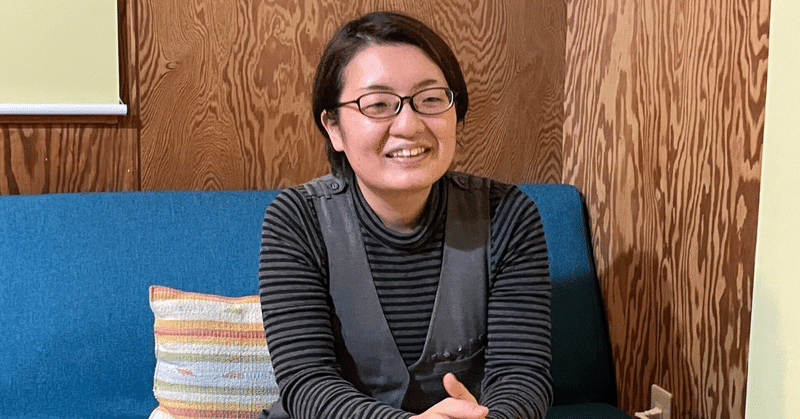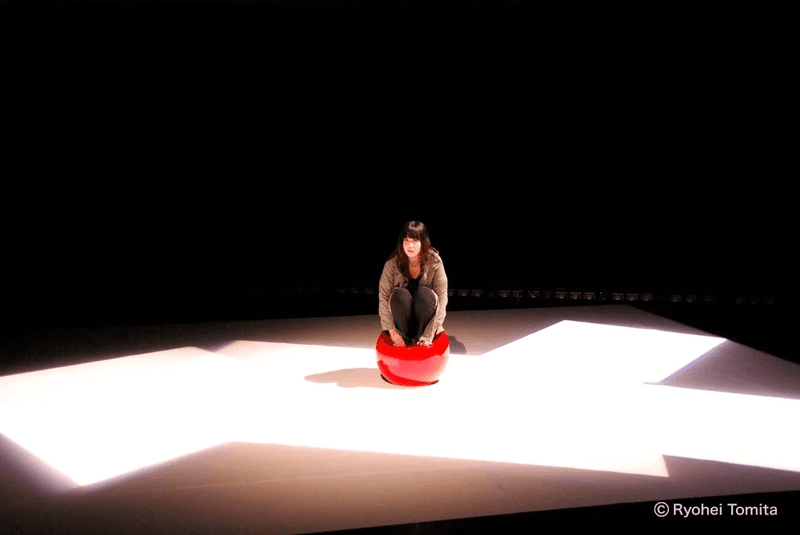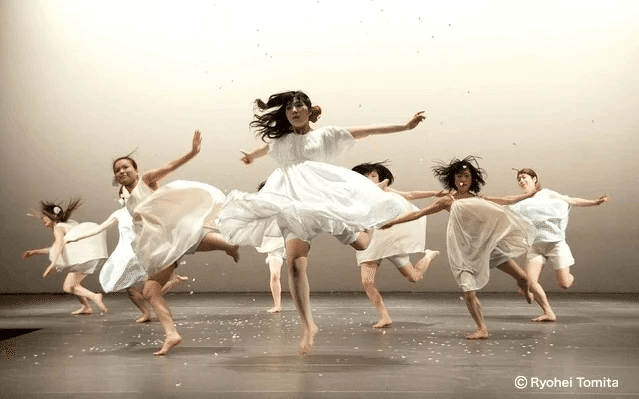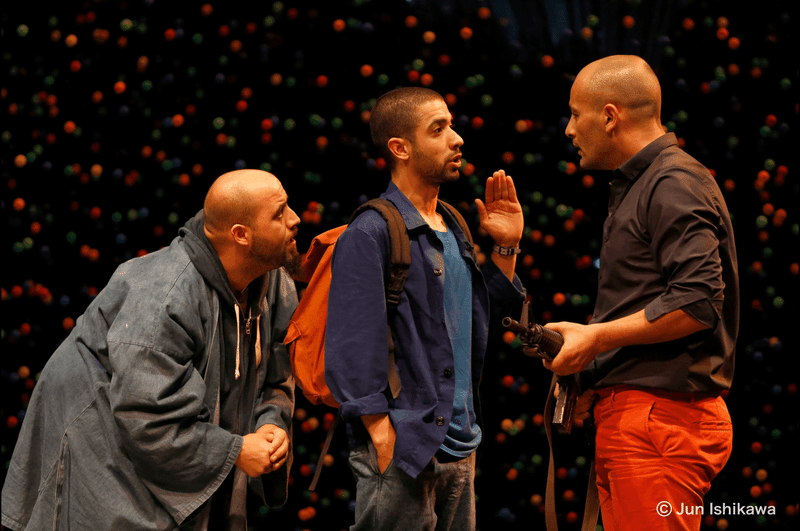
[Interview] Director Yukari Sakata Discusses the Journey to Arrive at Tera and Where TERASIA Is Headed
TERASIA: Theatre for Traveling in the Age of Isolation is an international collaborative project for a new era that launched in 2020 in the wake of the global COVID-19 pandemic. In November 2021, a ten-day virtual festival—TERASIA Online Week 2021—was held, with a series of performances and panel discussions featuring artists from Japan, Thailand, Vietnam, Myanmar, and Indonesia released to the public to great success.
TERASIA is a natural evolution of the theater piece Tera, originally staged in 2018 at Tokyo’s Saihō-ji Temple. Based on Jūrō Miyoshi’s verse drama "Daffodils and Wooden Fish," the play was created by interweaving literary works together with the local history of the temple, interviews with the head priest, and Buddhist sermons and sutras, exploring the themes of "temples," "Buddhism," and people's views of life and death in contemporary Japan.
Director Yukari Sakata, who directed the original production of Tera, now helms the TERASIA project as one of its founding members.
Sakata began her career as a director upon encountering physical expression at the Department of Musical Creativity and the Environment at the Tokyo University of the Arts. After graduating, she worked for five years as a technical staff member at stage theaters across Japan before returning to direct full-time in 2014. As director of Rashomon|Yabunonaka, featured at the Festival/Tokyo 2014 international performing arts festival, she co-created the piece with Al-Kasaba Theatre of Palestine.
In 2018, Sakata was again commissioned by Festival/Tokyo to create a new work, and invited actress Miho Inatsugu—a friend since her university days—drummer and percussionist Kyojun Tanaka, and interpreter/translator Maho Watanabe as dramaturg to collaborate in the creation of Tera. The work resonated with artists from all over Asia, and in 2020, in the midst of COVID-19 pandemic, a new project was launched to answer the question, "Is it possible to co-create internationally without physically crossing borders?” This project evolved into the four-year experiment called TERASIA.
What thoughts and feelings went into the creation of Tera, and what exactly is the TERASIA project? In this interview, Yukari Sakata shares with us insights on both the path she took to arrive at Tera, and where TERASIA—born from that path—will take us from here.

Sakata on Her First Encounter with Directing
Maho Watanabe, who served as dramaturg for both the original Tera and TERA in Kyoto, describes Sakata as an "extremely hard-working person.” For TERASIA Online Week 2021, she worked with scarcely a moment’s rest from the preparation stage to after the event was concluded, handling everything from administrative work to the creation of image visuals for each program and video editing.
Perhaps surprisingly for one who appears to the impartial observer as having devoted their entire life to theatre, Sakata’s initial motivation to learn directing at university was not a positive one. In fact, Sakata started out as a student in the Department of Music, having begun composing music and playing the piano from an early age.
“The friends I made immediately after entering university were really into music,” Sakata explained. One of these friends was Kyojun Tanaka, who composed and performed the music in Tera. “Watching them, I came to the realization that I really didn't like music all that much. So, as if to escape, I enrolled in a seminar on physical expression. My department—the Department of Musical Creativity and the Environment—allowed students to study across a variety of interdisciplinary fields, so there were seminars for research in areas other than music, such as arts management and contemporary art. At the time I chose the seminar, I was thinking, ‘Anything other than music... Anything other than music...’”
Despite having stepped into the field of physical expression by process of elimination, Sakata nevertheless was optimistic as she pursued the path of a director. “I had never studied theater before, so I figured I’d give it a try. Everyone wants to try something they've never done before, right?” It was in that seminar that she met actress Miho Inatsugu, who plays the main character of Mitsuko Kyōgoku in Tera.
Since their first director/actor collaboration in 2008’s BOMBSONG, when they were still students, Sakata and Inatsugu have collaborated on numerous productions. BOMBSONG, Proserpina (a work that was also Sakata’s graduation project), and Tera are all one-person narratives featuring Inatsugu’s monologues. From the earliest stages of Tera’s creation, Sakata set out to create a monologue that would become Inatsugu’s defining performance.
Sakata elaborates: “Monologues don’t involve the same sort of direction as dialogue plays, where the story is drawn from the relationships between people. Of course, monologues are originally words written in a script, but the actors have to chew those words over inside themselves to create a mental picture that they can narrate—something which we must then ‘improve’ upon in rehearsal. This is work that can’t be done with a mindset that says, ‘We cannot know what is in other people's hearts.’ The director must understand the actor’s state of mind—what they are thinking and feeling as they speak their monologue—then reflect it back to them like a mirror, and encourage them to change from the inside out. This kind of direction cannot be done without a true relationship of trusting.


The Birth of Tera
When Sakata accepted the invitation to participate in Festival/Tokyo 2018, the only thing that had been decided was that the stage would be "somewhere in the city.” She explains that at the time, her idea was "that it would be great if I could create an important work with Miho Inatsugu, and that if it was going to be within the city, maybe it could be set at a temple.
She continues: “At the time, I was studying abroad for graduate school, to research international collaboration in the field of fine art. I felt that whether or not an artist could survive in that world would depend on whether or not they could incorporate a sort of Japanese-ness as seen through foreign eyes into their work. But I felt that I couldn’t offer what foreign audiences were looking for from a Japanese artist. It was under such circumstances that I thought, ‘If I’m going to return to Japan, I want to create works that can only be created in Japan, with Japanese people, and using the Japanese language.
Among the endless "places" in Tokyo where a play could be staged, Sakata immediately thought of "temples" amidst questions that had arisen in her mind about Japan—where she was born and raised—after expanding her activities abroad. She explained:
"I had begun to wonder—why is discussing religion such a taboo in Japanese society? It really isn’t at all standard to talk openly here about faith and religion, to share one’s faith with others, or to live in a way that connects the ‘invisible,” such as the heart and soul, with the ‘visible,’ such as various real-life problems. In fact, one could even say it’s easier to get along comfortably in Japanese society by declaring they do not believe in God. It made me wonder what religion in Japan is all about.”
Among the doors separating the world of the "visible" and the "invisible", one would be death. Indeed, “death” is one of the most important themes to Sakata.
“If I hadn't entered the University of the Arts, I would have wanted to be a hospice nurse providing end-of-life care. Death is sad, but it’s something that you can’t overlook. It’s the last thing every one of us experiences. The thought came to me so naturally that I don't even remember what inspired it. A temple is a place for mourning, and there is a profession of priests whose job is to see off the dead, and there are also graves there. Perhaps that's why I was naturally drawn to temples."
Now with the twofold goal of creating a large work with Miho Inatsugu and staging it at a temple, Sakata in her search for inspiration came across Jūrō Miyoshi’s verse drama “Daffodils and Wooden Fish – A Girl Recites.”
“At the time, I was studying abroad in Athens and had limited access to Japanese literature. In the course of reading what few references were available to me, I came across ‘Daffodils and Wooden Fish’. It takes the form of a long, long poem written by Mitsuko Kyōgoku, a young woman who was raised at a temple.”
In 2014, Sakata directed Rashomon | Yabunonaka, a joint production with the Al-Kasaba Theatre of Palestine. She observed that the Palestinian actors accepted the task of "reading poetry in a play" as if it were completely natural, and was told that in Palestine, children learn to recite poems from a young age in elementary school.
“I was interested in performing poetry, which is not common in Japanese theater. Miho (Inatsugu) is able to take poetry to the point where she is almost acting it out rather than reading or reciting it. That’s one of the things about her that I really like.”

From Tera and Japanese Temples to TERASIA
The fully realized Tera took flight across borders almost immediately after the initial Tokyo performance staged in 2018. In 2019, it received an invitation from the Carthage Theatre Festival in Africa to go on tour in Tunisia, and performances in Asia were also being planned. In the midst of this, however, the global COVID-19 pandemic broke out. In the spring of 2020, as the situation in Japan was growing more serious, the "Theatre for Traveling in the Age of Isolation" project was born from a dialogue between dramaturg Maho Watanabe and her acquaintance, the Thai director/artist Narumol “Kop” Thammapruksa .
“We had Kop watch a recording of the Tokyo performance of Tera,” explains Watanabe. “And her response was, ‘I want to create this here in Thailand, by our own hands,’ which I thought was a novel idea. Through conversations with Kop, the name "TERA + ASIA = TERASIA" was born, and the subtitle "Theatre for Traveling in the Age of Isolation" was added. The concept was to let the works themselves travel—in the place of people and objects—and see how they mutate from place to place," Watanabe elaborated. Deconstructed and reconstructed by Kop and her trusted team of Thai artists and performers, Tera was reborn in the fall of 2020 as TERA เถระ (TERA TERA), with entirely original characters, music, and even a different literary work serving as the base and inspiration. At the same time, by Kop's initiative, the project expanded to include artists from Myanmar and Indonesia—meaning that within a month of its launch, four countries had already signed on to participate.
The activities of TERASIA: Theater for Traveling in the Age of Isolation have mutated and evolved in light of the circumstances of the destination countries and the artists' own hands, and have come to develop beyond the framework of "theater," as seen in the Vietnam team’s video work, and the contemporary visual art created by the artists in Myanmar.
In this way, TERASIA—which continues to produce such mutations—set out on its way, deciding in advance that four years later would mark the end of its journey. (At the time of the project’s launch, it was being predicted that the age of quarantine would end in four years.) The journey will culminate in the TERASIA Summit 2023 in Indonesia, scheduled to be held next year as the project’s grand finale. The goal for the summit is to bring together TERASIA team members from all over Asia, as well as to showcase works by Indonesian artists.
“The director Dindon W.S. has proposed a concept for a production of TERA in Indonesia, which he calls TERASIA Back to Nature. He expressed his wish as: ‘I hope the Indonesian people can look back to their past and cherish nature more,’ especially in the wake of the Corona disaster. This is where TERASIA goes back to nature."
The renditions of TERA created in various countries in Asia have no conditions imposed upon their creation, and there is no need for them to show the relationship with the original Tera work as performed in Tokyo, which was the starting point for the other TERA projects. This might lead one to ask—what exactly is TERA, then?
Sakata explained, “That's exactly what we plan to discuss at the 2023 summit. If we can figure out what exactly makes TERA "TERA", we can make it open source. That is our dream. It would be wonderful if we could create a future in which TERA is the common property of all humankind—no matter when, where, or by whom it is created, as long as it is TERA. At the moment, I’m not yet certain how we should define TERA. Maybe it doesn't have to be a temple. Maybe it doesn't have to be Buddhism. In this sense, I hope that the example set by TERASIA will spread as a new form of collaboration, and that it will convey the idea that this method of collaboration and creative potential existed in the age of the COVID-19 pandemic. To achieve this goal, we’re going to keep running forward through to 2023.”
This is the journey of artists in the COVID age, groping their way through the world with an unwavering determination to not stop creating. Whether it is simply the characteristic of a certain era or a sign of a new and universal trend, this continued movement connects us as we live and die—and may very well serve as a tale of adventure that gives us all the courage to embrace change.
(Interview and text by Mikiko Endo / English translation by John Townsend)
Yukari Sakata
Theater director, project assistant professor at Tokyo University of the Arts Public Collaboration Center. Since her directed work “Tera” evolved into the Asian collective “TERASIA: Theatre for Traveling in the Age of Isolation,” she continues to play a central role in planning and managing the project.
Mikiko Endo
Writer, planning and PR coordinator. Graduated from Tokyo University of the Arts, Department of Musical Creativity and the Environment.
John Townsend
Tokyo-based translator, writer, and editor. M.A. in Japanese Language and Literature from the Ohio State University. Received the Distinguished Translation Award in the 4th Shizuoka International Translation Competition. English translator of “Tera” and "Tera in Kyoto."
頂いたサポートは、打ち合わせ時のコーヒー代として、私たちの創作活動の励みとなります。 Your support supplies our team with an extra cup of coffee to boost creative energies. Thank you!
